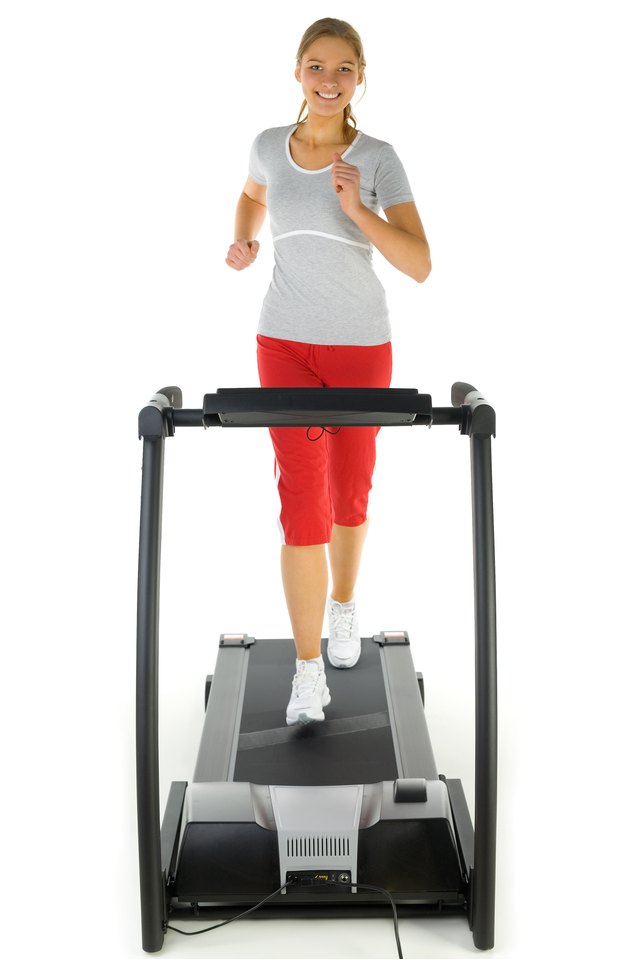Treadmill Exercises for Ages 40 and Over

A treadmill is an extremely versatile piece of exercise equipment that lets you customize your workout to meet your fitness goals and match your fitness level. You have the option of walking or running and you can vary the speed and incline to make your workout as effective as possible. While exercise is valuable at any age, if you are age 40 or over, your metabolism may be starting to slow down, and it might become more difficult to maintain a healthy weight. In addition, research reported in 2013 in the "Annals of Internal Medicine" showed that being fit after 40 can lead to reduced risk of serious medical conditions later in life.
Walk It Off
If you are just starting out on an exercise program, a treadmill allows you to start slowly with a walking routine. Over time, you can increase your speed and add elevation for more of a challenge as your strength and stamina increase. If you’ve never used a treadmill before, start at a slow pace, no more than 1.5 to 2.0 miles per hour, making sure you feel comfortable and balanced. After about five minutes at this warm-up pace, increase the speed slowly, working up to a moderate walking pace of 3.5 mph. When you’re ready, try adding some incline at a slow speed. A 20-minute session, including slower warm-up and cool-down periods of about five minutes each, is a good goal for starting out. Once you’re feeling comfortable, challenge yourself with increased speed and elevation to get the most out of your workout.
Pick Up the Pace
Running on a treadmill has some great advantages over running outdoors. Whether it’s at home or at the gym, a treadmill is an all-weather, year-round tool, so you have no excuses not to get your workout in. It is also very versatile, allowing you to adjust your speed and incline to mix up your workout each day. Losing muscle mass is a consequence of aging that begins after age 30, so taking advantage of the variety of options your treadmill offers for walking and running will help you combat this loss and maintain your strength and stability. Each workout should start with a five-minute warm-up at a moderate walking pace of about 3.5 miles per hour. You can then choose to add incline to the walking pace, increase the speed to a jogging or running pace, or a combination of both. Try alternating the approaches over the course of the week to keep things interesting, shooting for a 20- to 30-minute workout each day. Don’t forget to allow for a five-minute cool-down at the end of each session.
Mix It Up With HIIT
If you’re ready for a really aggressive workout, consider High-Intensity Interval Training. This approach, which is used with all types of endurance exercise, involves varying your exertion level between high and low during your workout. HIIT burns fat more effectively than jogging and improves your aerobic fitness as well. The real advantage to HIIT is that you can realize these benefits with a surprisingly short workout. Training expert Marc Perry recommends a treadmill workout that you can do in only five minutes, by alternately sprinting and resting for 30-second intervals. To get the maximum benefit from the high-intensity intervals, you need to really exert yourself, but be careful not to set the treadmill speed faster than you can safely maintain. You can rest by either staying on the treadmill and walking slowly or getting off the treadmill entirely.
Monitor Your Vitals
To make sure that your treadmill workout is both safe and effective, it is useful to monitor your heart rate. To figure out what your ideal heart rate should be during exercise, you first need to calculate your maximum heart rate. To do that, take your age and subtract it from 220 to get maximum beats per minute. If your fitness level is moderate, your target heart rate is 50 to 70 percent of your maximum heart rate. For those looking for -- and capable of -- a more high-intensity workout, shoot for maintaining 70 to 85 percent of your maximum heart rate.
References
- Annals of Internal Medicine: The Association Between Midlife Cardiorespiratory Fitness Levels and Later-Life Dementia
- Arthritis Foundation: What to Know About Using a Treadmill
- Built Lean: High Intensity Interval Training (HIIT): Best Cardio to Burn Fat
- Centers for Disease Control and Prevention: Target Heart Rate and Estimated Maximum Heart Rate
- Built Lean: Best HIIT Treadmill Workout to Burn Fat
- American Academy of Orthopaedic Surgeons: Seniors and Exercise
- Buurke TJW, Lamoth CJC, Van der Woude LHV, Den Otter R. Handrail holding during treadmill walking reduces locomotor learning in able-bodied persons. IEEE Trans Neural Syst Rehabil Eng. 2019;27(9):1753-1759. doi:10.1109/TNSRE.2019.2935242
- Boutcher SH. High-intensity intermittent exercise and fat loss. J Obes. 2011;2011:868305. doi:10.1155/2011/868305
- Slaght J, Sénéchal M, Hrubeniuk TJ, Mayo A, Bouchard DR. Walking cadence to exercise at moderate intensity for adults: A systematic review. J Sports Med (Hindawi Publ Corp). 2017;2017:4641203. doi:10.1155/2017/4641203
- Sperlich B, Wallmann-Sperlich B, Zinner C, Von Stauffenberg V, Losert H, Holmberg HC. Functional high-intensity circuit training improves body composition, peak oxygen uptake, strength, and alters certain dimensions of quality of life in overweight women. Front Physiol. 2017;8:172. doi:10.3389/fphys.2017.00172
Resources
Writer Bio
Based in coastal Maine, Irene Lang has more than 20 years of experience as a professional business writer. With an M.B.A. from Rutgers University, Lang’s writing has primarily been in the fields of marketing, health care and travel. Her work has been published online at various websites.
